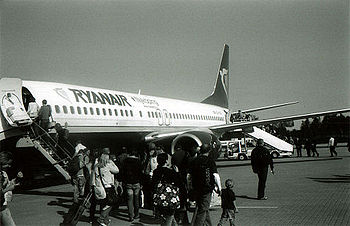In our travels, we have encountered several different boarding procedures. None of them seem to work particularly well, though all of them do have in common that we are somehow always the last allowed on. Our favorite part of these processes is the priority lane for special passengers. These VIPs are allowed to board first through this lane, and then the gate agent moves over 3 feet and begins taking plebes through an identical, adjacent lane.
Have no fear, Jason Steffen, a professor of physics and astronomy has shifted his attention from the stars to the clouds. He has devised, mathematically, what he believes to be the optimal solution to the boarding problem.
I’ve proposed an optimum boarding method. In this approach, often called the Steffen method, adjacent passengers in line will be seated two rows apart from each other. The first wave of passengers would be, in order, 30A, 28A, 26A, 24A, and so on, starting from the back. (For a typical airplane there would be 12 such waves, one for each seat in a row and for odd and even rows.)
In field tests, this method has outperformed all others. In a test with 72 passengers, it was nearly twice as fast as boarding back-to-front or in rotating blocks of rows, methods commonly used in the industry. It was 20-30 percent faster than more optimized boarding methods such as random boarding, when people get on without regard to where their assigned seats are. It also beat boarding windows-middle-aisle. My method even outperformed the industry gold standard of open seating, used by Southwest airlines. That’s when passengers don’t have assigned seats at all.
Steffen concedes that his method may be too complex to be practical, but advises that it represents a theoretical best case that all other methods can be adapted to. Â What was your best or worst experience with boarding?
Related articles
 There’s A Better Way To Board Planes(theatlantic.com)
There’s A Better Way To Board Planes(theatlantic.com)
 Passengers Boarding Airplanes: We’re Doing It Wrong(livescience.com)
Passengers Boarding Airplanes: We’re Doing It Wrong(livescience.com)
 There’s a Super-Fast Method for Boarding Planes, But Airlines Aren’t Using It(yahoo.com)
There’s a Super-Fast Method for Boarding Planes, But Airlines Aren’t Using It(yahoo.com)
 What’s Up With That: Boarding Airplanes Takes Forever(wired.com)
What’s Up With That: Boarding Airplanes Takes Forever(wired.com)
